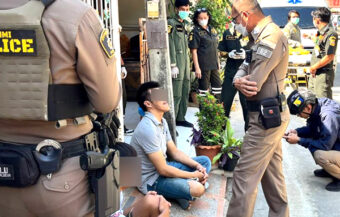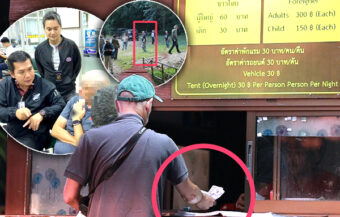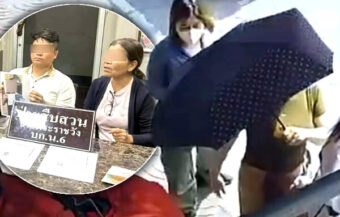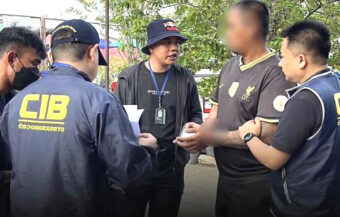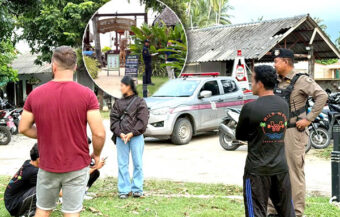Mother elephant returns to her newborn calf, Khao Tom, as veterinary experts race to save the tiny one-week-old calf suffering from a severe leg deformity, receiving intensive round-the-clock care in Kanchanaburi after being abandoned at birth.
The one-week-old elephant calf rescued on Monday is showing slow but steady progress, despite being abandoned hours after birth when her mother’s instincts judged she could not survive. Veterinary specialists have confirmed the tiny female suffers from a leg deformity, leaving her unable to walk or stand without help. Nevertheless, a dedicated and well-equipped team is fighting tirelessly to give her a chance, and she has already touched the hearts of every caregiver. Hope surged on Friday as the mother elephant—a tall, imposing figure—turned from the herd and headed back toward the spot where she left her calf.
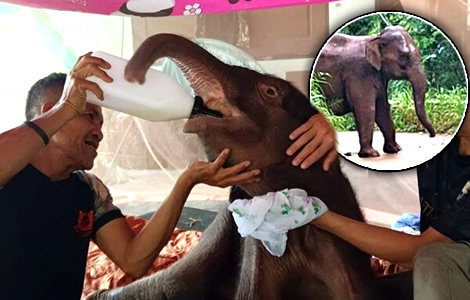
Thai government agency experts and National Park officials reported on Friday that a mother elephant, separated from her herd, appears to be returning to her newborn calf. The calf, discovered by rescuers on Monday in the Chalae subdistrict of Kanchanaburi, has been named Khao Tom. Consequently, park and wildlife officials are closely monitoring the mother as she moves toward her offspring.
Khao Tom is making slow but steady progress under intensive veterinary care. However, veterinarians confirmed that the calf suffers from a congenital leg deformity. This injury prevents her from walking and standing without assistance.
Therefore, officials believe her mother, following natural instincts, abandoned her when the herd moved on. Reports indicate that the herd already includes several newborn calves.
Mother elephant may have abandoned her calf after instincts judged she could not survive the wild alone
Meanwhile, Thai authorities are consulting with veterinary experts to design a precise treatment plan for Khao Tom. Elephant surveillance teams suspect that a tall female elephant named Suksan, believed to be Khao Tom’s mother, was seen moving away from the herd. They report she was heading toward Phuchani, the location where the calf was born, likely searching for her baby.
Lam Khlong Ngu National Park officials, local community leaders, and elephant watchers observed Suksan returning to Phuchani after separating from the herd. They believe she may have come back to check on her offspring. Observations were recorded on September 26, 2025.
Earlier, the one-week-old elephant calf was separated from her mother in Thong Pha Phum District, Kanchanaburi Province sometime last weekend. Officials from the Department of National Parks, Wildlife and Plant Conservation, on Monday, transported the calf to the Bueng Chawak Wildlife Management Development Centre in Suphan Buri Province. There, veterinary staff confirmed her congenital malformation, requiring 24-hour intensive care. Her condition is stable, although careful monitoring is crucial.
Officials closely monitor mother elephant’s movements as experts plan intensive treatment for calf
At 2:30 p.m. on Friday, Mr. Sunthon Wanthong, village headman of Ban Thung Nang Kran, Cha Lae Subdistrict, Thong Pha Phum District, led a team of officials from the wild elephant push unit and Lam Khlong Ngu National Park. They set out to monitor wild elephant movements and protect local crops. Therefore, they travelled from Ban Thung Nang Kran to Ban Thung Suea Thon to observe the herd.
Upon reaching the intersection near Kitty Thung Suea Thon, Khao Phra In, and Phu Toei roads, they spotted a herd of wild elephants foraging nearby. Among them was a tall female with large breasts, resembling a nursing mother.
Officials identified her as Pang Suksan, believed to be Khao Tom’s mother. She had separated from the herd and crossed the road, heading toward Huai Chanee, the calf’s birthplace. The location was approximately 2.5 kilometres from Huai Chanee.
Observations indicated the herd included more than 20 elephants, with two to three newborn calves. Consequently, authorities issued public notices advising villagers to avoid the area to prevent accidents and conflicts with the wild elephants.
Villagers warned that a mother elephant was observed returning to check on calf with a herd nearby
The rescue operation for Khao Tom began after the calf was discovered abandoned in the forest on Monday September 22. She was only a day old when found near Huai Suea village in Chalae subdistrict, Thong Pha Phum District. Immediately, park officials, volunteers, Buddhist monks, and elephant monitoring teams launched a rescue mission.
Khao Tom’s mother, a 20-year-old elephant named Mae Suksan, had abandoned her because she appeared too weak to survive the herd’s migration.
Experts explain that wild elephants sometimes leave newborns when survival is unlikely. “The mother elephant left the calf because it was not strong enough after birth,” said Prathom Han Klang, an elephant behaviour expert at the Elephant Conservation Foundation.
The calf was immediately named Khao Tom, meaning Rice Porridge. Officials warned that her chances of survival remained low. Nevertheless, caregivers were determined to provide intensive round-the-clock care.
Intensive care and feeding routines set up to help fragile elephant calf recover under expert supervision
Khao Tom was transported to the Forest Protection Unit under the supervision of Akkanit Klangpraphan, head of Lam Khlong Ngu National Park. Veterinarians discovered general weakness and a right hind leg injury. Consequently, she could not stand without support. This made the rescue operation both delicate and urgent.
Care teams provided 24-hour monitoring and feeding. Initially, Khao Tom received rice water and infant formula. Later, caretakers switched to a more suitable Enfalac milk formula.
Additionally, milk from elephant mothers at Wang Chang Lae Paniat elephant camp in Ayutthaya Province was transported under strict temperature control. Officials warned that any mishandling could have been fatal.
During the night, caretakers closely observed Khao Tom’s behaviour. At 11:30 p.m., she drank a substantial amount of rice water. At 3:00 a.m., she received an additional 300 millilitres. She urinated 30 to 50 millilitres, showing normal bodily function. However, her injured leg could not support her weight. By 6:00 a.m., she received another 600–700 millilitres of milk. Gradually, she attempted to sit up, with staff providing continuous support to prevent complications from lying too long.
Veterinarians continue monitoring injured calf as teams provide 24-hour care for survival and rehabilitation
Despite repeated efforts, Khao Tom still cannot stand. Veterinarians continue evaluating her leg and developing treatment plans. This case illustrates the harsh realities of wild elephant survival. Mothers sometimes face impossible choices, leaving vulnerable calves dependent on human intervention.
Later on September 22, Khao Tom was transferred to Bueng Chawak Wildlife Management Development Centre in Suphan Buri Province. There, she is under the care of Dr. Phatthraphon Mani-on, Head of Wildlife Health Management at the Wildlife Conservation Office. Dr. Mani-on posted video footage showing the calf flapping her ears and playing during transit.
Officials emphasise that each feeding, movement, and medical procedure must be controlled carefully. The calf’s fragile condition requires constant monitoring and patience. Care teams adjust schedules, feeding amounts, and medical interventions daily.
The rescue highlights the extensive coordination required to save a single abandoned elephant. Park officials, volunteers, monks, and donors worked seamlessly. Transport, milk provision, and medical supervision were executed without delay. Their teamwork gave Khao Tom a vital chance at survival.
Coordinated efforts from volunteers and officials give the fragile elephant calf a fighting chance at life
Although progress is slow, Khao Tom shows signs of upper-body strength. She attempts small independent movements. Caregivers provide leg exercises and proper positioning to avoid complications. Hydration, digestion, and feeding responses are closely monitored.
Khao Tom’s situation underlines both elephant vulnerability and the critical role of human intervention. Weak newborns rarely survive in the wild. With proper veterinary care and round-the-clock supervision, even fragile calves can survive.
For now, Khao Tom’s condition is critical but stable. Caretakers maintain continuous vigilance, understanding that every day is vital. The rescue demonstrates the dedication, expertise, and resources required to safeguard Thailand’s elephants.
Her story also highlights broader conservation challenges. Habitat loss, human encroachment, and natural pressures force mothers to make difficult decisions. Consequently, human intervention becomes essential for newborn survival. Experts stress that such cases demand specialised veterinary care and constant observation.
Human intervention is essential to ensure the survival of weak elephant calves in threatened habitats
The rescue illustrates the extraordinary effort needed to save even one abandoned elephant. Transport, milk preparation, feeding, and medical treatment require coordination and precision. Every action directly affects the calf’s chance of survival.
Khao Tom’s progress, although gradual, shows promise. She demonstrates strength in her upper body and responds to careful leg exercises. Caregivers continue supporting her with positioning, feeding, hydration, and monitoring to maximise recovery.
Her story resonates beyond a single rescue. It demonstrates the vulnerability of wild elephants, the difficult choices mothers face, and the life-saving role humans play in conservation. Without intervention, weak calves rarely survive. With proper care, survival is possible.
Each step in recovery for Khao Tom highlights the dedication needed to protect Thailand’s wild elephants
In the coming weeks, Khao Tom’s condition will be closely monitored. Feeding, medical treatment, and physical support will continue to be adjusted daily. Each milestone, no matter how small, marks vital progress toward recovery.
Currently, the one-week-old calf remains critical but stable. Dedicated teams of veterinarians, park officials, and volunteers continue providing round-the-clock care. The rescue demonstrates both the fragility of wild elephants and the dedication required to protect them.
Rescue effort for elephant calf found in Kanchanaburi Monday. Abandoned by mother as too weak to walk
Khao Tom’s story will be followed closely. Each movement, feeding, and medical treatment will be documented. Her survival depends on constant care, precise handling, and the dedication of humans committed to protecting Thailand’s wildlife.
Join the Thai News forum, follow Thai Examiner on Facebook here
Receive all our stories as they come out on Telegram here
Follow Thai Examiner here
Further reading:
Concerns raised about EV vehicles and batteries stored in Bangkok following intense Chatuchak fire
Thailand faces an economic test as change becomes a reality in cars, farming and business
Friday evening horror smash in southern Thailand wipes out family riding pillion on a motorbike











